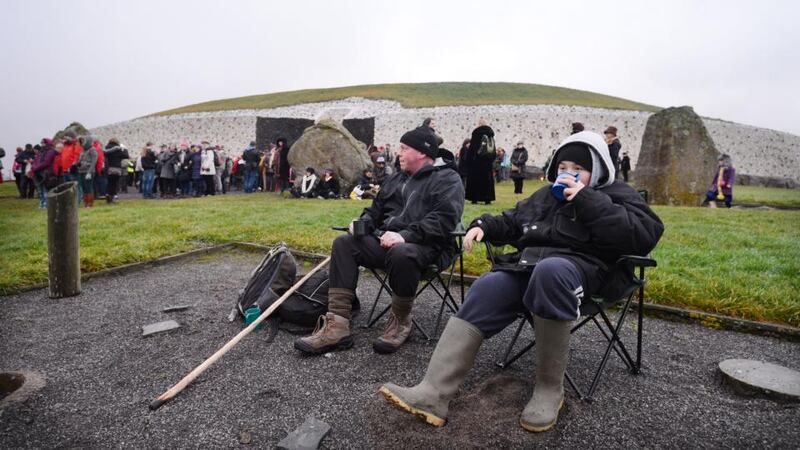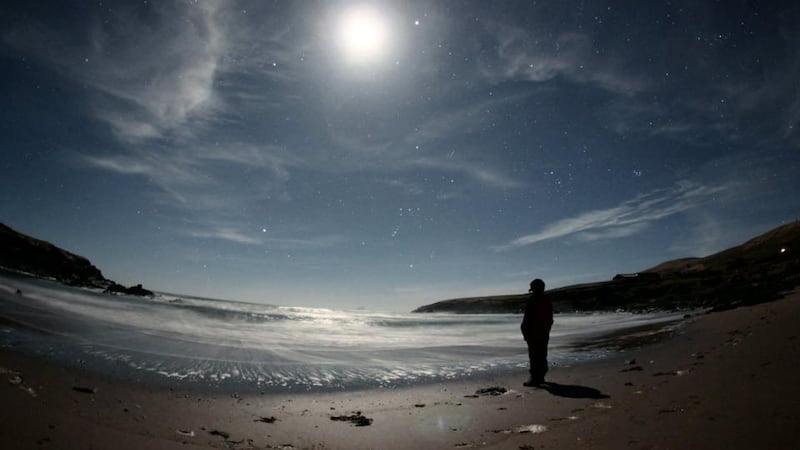People look to the skies at Christmas, some watching for a Yuletide star pointing the way and others for flying reindeer and a jolly character dressed in a red suit.
More seasonal symbolism is offered by the passage graves of Newgrange, Dowth and Knowth along the River Boyne. Renewal and rebirth at the rising of the sun is the shared theme expressed by the builders of these 5,000-year-old monuments and by the Christian churches.
It is no accident that the winter solstice and Christmas fall so close together on the calendar, as older festivals have given way to modern versions. The names change but the themes remain closely linked.


Only the hardy will brave the dawn cold on December 21st to see the sunrise at Newgrange, and the lucky few assembled in the far recesses of that large grave will hope to see the magic once again as the sun begins its journey towards spring.
The astronomical alignments achieved during the monument’s construction attest to the importance of astronomy to the ancient people who built it. And astronomy was there again in the Christmas story as the Wise Men from the east delivered their gifts, guided by the light of a star that pointed the way.
Today it is much easier to peruse the stars, since you can take the car rather than having to ride a camel for weeks.
The Kerry International Dark-Sky Reserve is an ideal place for viewing the night sky, and it is one of only three Gold Tier reserves on the planet, as determined by the International Dark Sky Association. From there you can watch for a star or for that character riding the reindeer-pulled sleigh; it's entirely up to you.
"What you will see is the Milky Way; you have to have a black sky to see [its] band," says the Kerry Reserve's manager, Julie Ormonde. "You can see the Andromeda galaxy with the naked eye. You are seeing things 2½ million light years away."
Our fascination with the night sky is not the only common point linking present to past. Many of the social traditions we enjoy today date back hundreds of years, and in some cases even earlier.
"Christmas was the major festival of the year for Christian Ireland and there is a whole nexus of traditions surrounding it," says Críostóir Mac Cárthaigh, an archivist at the National Folklore Collection at University College Dublin.
The holly and the ivy
Many seasonal traditions that are very familiar to us date from a distant past. Holly and ivy were used to decorate the house because of their wintertime colour, and, in the case of holly, the bright red berries. Mistletoe was also there as an evergreen, but the notion of using it to capture a kiss was an American practice.
“There was also a big emphasis on the perambulatory traditions: going house visiting and presenting folk dramas,” says Mac Cárthaigh. The December 26th visitation of the wren boys is an example.
“The wren tradition appears to be very old, likely back to prehistory,” he says. “The wren boys seem to be part of a wider western European tradition, but it survives to the present in Ireland. A French scholar has studied this, and she argues that the sacrifice of the wren at this time of year is paying the debt of nature: spilling blood as an offering and fertilising the ground.”
There was also a powerful community aspect to this. “There is a very strong social dimension to the folk dramas. They were inclusive: the more houses involved, the better,” he says. “If somebody was shunned and got no visit from the boys, or if you were a difficult neighbour or wouldn’t accept social norms, this was important.”
While the wren boys were native Irish and Norman, the mummers were found in the Pale. “The mummers replaced an older wren tradition across most of Ulster and a good swathe of the east coast: areas of plantation,” he says. “They put on complex dramas revolving around death and then resuscitation.”
These performances were followed by drinking and feasting, all of which would look familiar to us today. Research, whether related to astronomy or to social conduct from 400 years ago , allows us to better understand where we came from and where we are headed as 2015 beckons.
STELLAR BIRTH: WHAT DID THE THREE KINGS FOLLOW?
Astronomers have long sought a possible explanation for the star of Bethlehem that lit the way for the wise men of the East travelling to meet the newborn king of the Jews.
A comet, a large shooting star, a nova or even a supernova have all been proposed, but none fits the bill, says Terry Moseley, president of the Irish Astronomical Association. All of these would have been highly visible and recorded by Roman rulers in Jerusalem or by the Chinese, who were avid chroniclers of such events, but no such record exists.
It might be that it was not an astronomical event but an astrological occurrence that gave the Magi their guiding light to Bethlehem, he suggests.
The theory that satisfies most astronomers is that the star was an astrological “triple conjunction” of the planets Jupiter and Saturn while in the constellation of Pisces.
These conjunctions occur when Jupiter in its orbit catches up and passes out Saturn and then seems to move backwards before advancing again for a third pass by Saturn, he says. "I have seen only one my entire life; that is how rare they are, he says. "The three Magi were astrologers not astronomers, and they knew this was going to happen; a triple conjunction is not a short-term event."
This would explain why only the Magi seemed to take note of the stellar sign and why it lasted long enough for them to journey to Bethlehem. Jupiter was considered the king of planets, while Pisces was associated with the Jews: the Magi could have interpreted this as a clear sign of a new king of the Jews.









